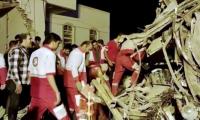The pandemic helped us achieve interesting feats as well. The expediency of the pandemic pushed us towards developing the ‘Core Capacities’ in our healthcare system we hitherto lacked. These Core Capacities i.e. ‘prevent, detect and respond’ are part of International Health Regulations and are envisaged in Punjab Health Sector Strategy 2019-2029 as well.
It was unfortunate that the last government had made little efforts on Crisis Management and Epidemic Response. We had to start from scratch to develop these capacities, turning this colossal challenge into a historic opportunity. A milestone at that stage was the improbable task of developing 1,000-bed Expo Center Field Hospital within nine days. This facility was used to quarantine suspected and confirmed patients. It has now been transformed into one of the largest vaccination centers of the country.
Another milestone was building testing capacity from scratch as the Pandemic progressed. Starting from just three labs in March 2020, we now have 22 Public sector Laboratories with the capacity to perform over 25,000 tests per day. Indeed, when the first lockdown was introduced on 20th March 2020, we had a cumulative testing capacity of just over 600 tests per day in all public and private labs.
During the course of the Pandemic, we kept on analyzing the exact scale of the mortality. We analyzed data of burials at different graveyards in Lahore to determine if at all there was any noticeable increase due to unreported deaths from COVID-19. With the exception of Miani Sahib graveyard in Lahore (48 Corona related reported burials in the peak month of June 2020) the rise in number of burials elsewhere was not significant even though Corona as a national emergency elicited diversion of resources to the Pandemic thereby contributing to increase in mortality from other causes. A study on pre and post Pandemic mortality and burials in Punjab with focus on hotspot areas is also being conducted to fully understand this perspective.
However, desk analysis of key indicators, findings of different surveys and information from multiple sources indicate that the number of cases and mortality rate were not as significantly under reported as initially thought.
The pandemic presented certain caveats for us to build upon. Foremost was that health, economy and development are interwoven and integrated. The emerging concept of One Health is the pivot around which we need to further develop our larger development edifice. A modest beginning was that we aligned our workplans with targets of the larger UN Sustainable Developments Goals.
Second is that Health no longer is the responsibility of the government alone. This Pandemic amply proves that challenges of the new era i.e. Pandemics/epidemics from Corona to Polio, overcrowded hospitals, stunted growth, blood borne diseases (Hepatitis, HIV etc), universal coverage, climate change, research & development and social safety nets are as important for the Academia and the Private Sector as for the Government.
Taking lead, the Government is acting as bridge for inclusive and meaningful partnerships. We need to think and act out-of-box. I am aware that we have a lot of catching up to do.
Three, we must stay in sync with the world on latest diagnostics, telemedicine, trainings, genomics, bio-forensics, research & data analysis, technology-based Patient Referral models and contact-tracing both in routine and emergency modes. We had set these goals in Punjab Health Sector Strategy, yet the Pandemic taught us that we have to stay ahead of timelines as you can be caught underprepared at any point of time.
Fourth is development of a culture for evidence-based decision-making. With the exception of some institutions, there was a disappointing lack of initiative on research and analysis two years back. In the last one year, it is heartening to see research papers and studies published by our health experts in leading universities. Our universities must produce the quality that we need to face 21st century challenges. Evidence-based decision-making requires precision in data collection and quality in research. We are working on enhancing collaboration among the Government Departments and the Academia to promote a culture of research.
Fifth is the status of preparedness and resilience for crises and challenges. By the start the Pandemic, we were nowhere on fighting emergencies. From diagnostics to High Dependency and Isolation Units, ICUs and trained HR, we were at the edge of a disaster that we were able to avert. In the last one year, we have developed capacities and the system has been made resilient for years to come.
In the end, let me reiterate that the Pandemic is not over by any means. We have for the time being made breakthroughs against the virus but our battle with it may continue. We have to outpace its mutations with our research to keep it at bay. (The writer retired as Professor of Obstetrics and Gynecology at King Edward Medical University Lahore and currently serves as Health Minister of Punjab)
PTI maintain leading position in NA elections, with narrow lead of one percentage point over PMLN
Nationalists say province's resources, land, and water were being sold under guise of development







